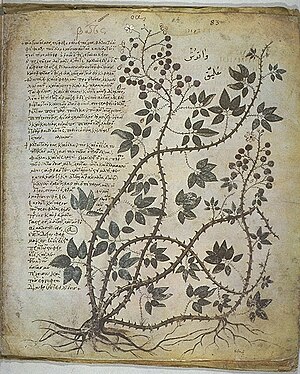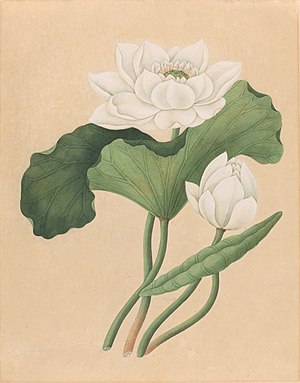Botanical Illustration
Botanical illustration is the art of depicting the form, color, and details of plant species.
They are generally meant to be scientifically descriptive about subjects depicted and are often found printed alongside a botanical description in books, magazines, and other media. Some are sold as artworks. Often composed by a botanical illustrator in consultation with a scientific author, their creation requires an understanding of plant morphology and access to specimens and references.


Many illustrations are in watercolour, but may also be in oils, ink, or pencil, or a combination of these and other media. The image may be life-size or not, though at times a scale is shown, and may show the life cycle and/or habitat of the plant and its neighbors, the upper and reverse sides of leaves, and details of flowers, bud, seed and root system.
The fragility of dried or otherwise preserved specimens, and restrictions or impracticalities of transport, saw illustrations used as valuable visual references for taxonomists. In particular, minute plants or other botanical specimens only visible under a microscope were often identified through illustrations. To that end, botanical illustrations used to be generally accepted as types for attribution of a botanical name to a taxon. However, current guidelines state that on or after 1 January 2007, the type must be a specimen 'except where there are technical difficulties of specimen preservation or if it is impossible to preserve a specimen that would show the features attributed to the taxon by the author of the name.' (Arts 40.4 and 40.5 of the Shenzen Code, 2018).
History
This section needs additional citations for verification. (October 2021) |




Early herbals and pharmacopoeia of many cultures include illustrations of plants. Botanical illustrations in such texts were often created to assist with identification of a specie for some medicinal purpose. The earliest surviving illustrated botanical work is the Codex vindobonensis. It is a copy of Dioscorides's De Materia Medica, and was made in the year 512 for Juliana Anicia, daughter of the former Western Roman Emperor Olybrius. The problem of accurately describing plants between regions and languages, before the introduction of taxonomy, was potentially hazardous to medicinal preparations. The low quality of printing of early works sometimes presents difficulties in identifying the species depicted.
When botanical nomenclature began to be systematized and texts on taxonomic classifications were regularly published by scientific organizations and academic institutions, botanical illustrations became common requirements for popular usability and referential quality of these texts. New printing processes in the 18th century and on allowed artists such as Franz and Ferdinand Bauer to depict minute aspects and render more accurate color portrayals of subjects. Widening interest in natural history and horticulture stimulated production of many floras and other publications on natural sciences. Amateur botanists, gardeners, and natural historians provided a market for botanical publications and illustrations increased the appeal and accessibility of these to the general reader. Exploded details accompanied text and highlighted specific features of subjects described, allowing lay-audiences to more easily identify species.
Botanical illustration is a feature of many notable books on plants, of which a few include Vienna Dioscurides, Flora Graeca, The Banksias, and The Cactaceae. Curtis's Botanical Magazine (1787), a 230-year-old magazine long-associated with the Linnaean Society and Kew Gardens, is now primarily one of finer botanical illustration.
Field guides, floras, catalogues and magazines produced since the introduction of photography to print material have continued to include illustrations. A compromise of accuracy and idealized images from several specimens can be easily (re)produced by skilled artists. Illustrations are also at times just preferred for some print/digital audiences or text formats.
The contributions of botanical illustrators continue to be praised and sought and very fine examples continue to be produced. In the 1980s, Celia Rosser undertook to illustrate every Banksia species for the masterwork, The Banksias. When another species was described after its publication, Banksia rosserae, it was named to honour her mammoth accomplishment. Other illustrators, such as the prolific Matilda Smith, have been specifically honoured for this work. In 1972, the Smithsonian Institution hired its first botanical illustrator, Alice Tangerini.
Recently, a renaissance has been occurring in botanical art and illustration. Organizations devoted to furthering the art form are found in the US (American Society of Botanical Artists), UK (Society of Botanical Artists), Australia (Botanical Art Society of Australia), and South Africa (Botanical Artists Association of South Africa), among others. There is an increasing interest in the changes occurring in the natural world and in the central role plants play in maintaining healthy ecosystems. A sense of urgency has developed in documenting today's plant life for future generations. Original botanical illustrations rendered in traditional media (with which art conservators are more familiar) can and might serve as reference research materials for endangered species.
Notable botanical illustrators
Notable botanical illustrators include:
- James Andrews
- George French Angas
- Claude Aubriet
- Alois Auer
- Françoise Basseporte
- Ferdinand Bauer
- Franz Bauer
- Mary Foley Benson
- Elizabeth Blackwell
- Harry Bolus
- Priscilla Susan Bury
- Olivia Marie Braida-Chiusano
- Mark Catesby
- Lise Cloquet
- Gillian Condy
- Léon Camille Marius Croizat
- Dioscorides
- Catharina Helena Dörrien
- Atanasio Echeverria y Godoy
- Sydenham Edwards
- Georg Dionysius Ehret
- James Henry Emerton
- Barbara Everard
- Walter Hood Fitch
- Barbara Jeppe
- Martha King
- Jacques le Moyne
- Dorothy van Dyke Leake
- Cythna Letty
- Carl Axel Magnus Lindman
- Margaret Mee
- Maria Sibylla Merian
- Philippa Nikulinsky
- Marianne North
- Pierre-Joseph Redouté
- Sarah Rhodes
- Lewis Roberts
- Celia Rosser
- Ellis Rowan
- Vera Scarth-Johnson
- Ellen Isham Schutt
- Dorothea Eliza Smith
- Matilda Smith
- Lilian Snelling
- Gerard van Spaendonck
- James Sowerby
- Sydney Parkinson
- Alice Tangerini
- Frances Elizabeth Tripp
- Elizabeth Twining
- Pierre Jean François Turpin
- Ellaphie Ward-Hilhorst
Awards
The Linnean Society of London awards the Jill Smythies Award for botanical illustration.
See also
References
Further reading
- De Bray, Lys (2001). The Art of Botanical Illustration: A history of classic illustrators and their achievements. Quantum Publishing, London. ISBN 1-86160-425-4.
- Blunt, Wilfrid and Stearn, William T. (1994). The Art of Botanical Illustration. Antique Collector's Club, London. ISBN 1-85149-177-5.
- Morris, Colleen; Louisa Murray: (2016). The Florilegium: the Royal Botanic Gardens Sydney celebrating 200 years: plants of the three gardens of the Royal Botanic Gardens and Domain Trust, The Florilegium Society at the Royal Botanic Gardens, Sydney. ISBN 978-099-447790-3
- Sherwood, Shirley (2001). A Passion for Plants: Contemporary Botanical Masterworks. Cassell and Co, London. ISBN 0-304-35828-2.
- Sherwood, Shirley and Rix, Martyn (2008). Treasures of Botanical Art. Royal Botanic Gardens, Kew. ISBN 978-1-84246-221-8.
- "Index". Australian Plant Collectors and Illustrators 1780s-1980s. Australian National Herbarium. Retrieved 2008-10-02.
- "Women Illustrators". The Art of Botanical Illustration. University of Delaware Library. Retrieved 2008-10-02.
- "Home page". Hunt Institute for Botanical Documentation. Carnegie Mellon University. Archived from the original on 2008-05-09. Retrieved 2008-10-02.
- Lack, H. Walter (2021). A Garden Eden: Masterpieces of Botanical Illustration. Taschen. ISBN 978-3-8365-7739-7.
External links

- American Society of Botanical Artists
- Art Serving Science: Solutions for the Preservation and Access of a Collection of Botanical Art and Illustration
- Botanical Art Society of Australia
- Botanical Drawings of carnivorous plants from the John Innes Centre Historical Collection Archived 2018-04-03 at the Wayback Machine
- Plantillustrations.org: searchable database of historic illustrations
- Botany.si.edu: online Smithsonian catalogue
- Flora of New Granada (Colombia) Drawings online, from the Royal Botanical Expedition led by Jose Celestino Mutis
- Traveling Artist Wildflowers Project
- University of Delaware: 'The Art of Botanical Illustration' exhibit
This article uses material from the Wikipedia English article Botanical illustration, which is released under the Creative Commons Attribution-ShareAlike 3.0 license ("CC BY-SA 3.0"); additional terms may apply (view authors). Content is available under CC BY-SA 4.0 unless otherwise noted. Images, videos and audio are available under their respective licenses.
®Wikipedia is a registered trademark of the Wiki Foundation, Inc. Wiki English (DUHOCTRUNGQUOC.VN) is an independent company and has no affiliation with Wiki Foundation.